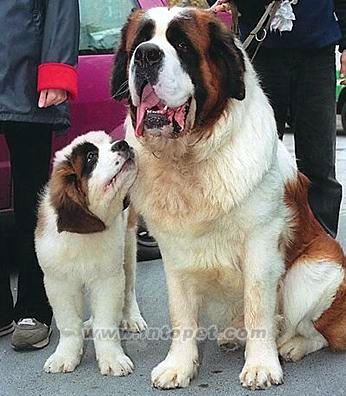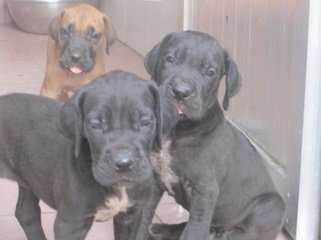概述:
图:慈悲为怀的圣伯纳狗,是当之无愧的犬中“圣徒”
圣伯纳,瑞士国犬,从英文直译过来,是“圣徒伯纳德”。它的外貌、体魄、强有力的四肢和阔大的头部,告诉我们它确系马鲁索斯犬家族的一员。它健美、有力,却总显出一副悲天悯人的表情。它忠诚、亲善,是孩子们天然的、或者说是天赐的守护使者。作为工作犬,它几乎无需接受什么专门的培训,因为涉险搜救、使人免于“白色死亡”(theWhiteDeath。特指死于冰天雪地)是它的天职,这一特殊的本能似乎深深铭刻在它的种姓之中。其非凡的嗅觉使它可以找到埋在雪下几英尺的人;其过人的体力和耐力让它可以背负伤员奔跑数十英里。更为神奇的是,它有着极其发达的知觉和感觉系统,对暴风雨、雪崩之类的突发的危险和事变,似有第六感(即超感),能够准确预测和预报,其实,是因为它能听到频率很低的声音。
一只品性优良、经过训练的圣伯纳是温柔、深情的狗,虽然颇为懒散,但已足以保护你的家园免于侵扰。
圣伯纳:温和、硕大的力量型动物。它聪明,并值得信赖,是饲主家庭所有成员的好伙伴。
别名:
圣伯纳猎犬(St. Bernhardshund), 高山獒犬或阿尔卑斯獒犬(AlpineMastiff),圣伯纳狮犬(Saint Bernard Leon),巴里狗(BarryDog)。
原产地:
瑞士圣伯纳大关口(Switzerland,The Greatof Bernard pass)。
种群划分:
獒犬。被AKC认定为工作犬,同时被FCI认定为无须工作测评(Withoutworking trial)的犬种。
在FCI分类中,被列为第2组即(有德国血统的刚毛小猛犬)和髯狗类(德国种,刚毛、浓眉型),以及马鲁索斯犬和瑞士城堡犬(SwissCastleDogs)类。同时被归入第22-2部分,即马鲁索斯山地犬类(Molossian,Mountaintype)。
认证情况:
1885年,由AKC最先予以认证。
其他认证组织: FCI, ANKC, CKC, UKC,KCGB, NKC, NZKC。
FCI规格排序:第61号。
附:圣伯纳犬 AKC 标准
Pronunciation
Saint BernardDescription
The Saint Bernard is a very large, strong, muscular dog, with apowerful head. As long as the weight stays in proportion with theheight, the taller the dog the more prized. There are two types ofcoat: rough, and smooth, but both are very dense and come in whitewith markings in tan, red, mahogany, brindle, and black - invarious combinations. The face and ears are usually shaded withblack and the expression is intelligent and gentle. In therough-coated dogs, the hair is slightly longer and there isfeathering on the thighs and legs. The feet are large with strongwell-arched toes, making the Saint Bernard's sure-footed in thesnow and ice. They have a highly developed sense of smell and alsoseem to have a sixth sense about impending danger from storms andavalanches.Temperament
They are extremely gentle and friendly and very tolerant ofchildren. The Saint Bernard is slow moving, patient, and obedient.Extremely loyal, this breed wants to please. Since this dog is sogiant, be sure to socialize it very well at a young age with otherpeople. It is highly intelligent and easy to train, howevertraining should begin early, while the dog is still a manageablesize. Bear in mind that an unruly dog of this size presents aproblem for even a strong adult if it is to be exercised in publicareas on a leash, so take control from the onset. The Saint Bernardis a good watchdog. Even its size is a good deterrent. They droolafter they drink or eat.
Height, Weight
Height: 25.5-27.5 inches ( 61-70 cm.)
Weight: 110-200 pounds (50-91 kg)Health Problems
Good health but some are prone to "wobbler" syndrome, heartproblems, skin problems, hip dysplasia, and extropion - a foldingoutward of the eyelid rim, usually on the lower lid. Twistedstomachs should be watched for. As these dogs are prone to bloat,it is best to feed them two or three small meals a day instead ofone large meal.Living Conditions
The Saint Bernard will do okay in an apartment if it issufficiently exercised. They are relatively inactive indoors and asmall yard is sufficient. They can live outdoors, but would muchrather be with their family. They have a low tolerance for hotweather, warm rooms, and cars.Exercise
A long walk each day will keep the Saint Bernard in good condition.Puppies should not have too much exercise at one time until theirbones are well formed and strong. Short walks and brief playsessions are best until the dog is about two years old.LifeExpectancy
About 8-10 years.Grooming
Both types of coats are easy to groom. Comb and brush with a firmbristle brush, and bathe only when necessary. Shampoo may strip thecoat of its oily, water-resistant properties, so use a mild soap.The eyes, which may be inclined to water, need special attention tokeep them clean and free of irritants. This breed sheds twice ayear.Origin
This is a very ancient breed. It was founded in AD 980 by StBernard de Menthon as a refuge for travelers through the perilousAlpine pass between Switzerland and Italy. It is descended from theTibetan mastiff and therefore must have originated with the mastiffbrought to the Alps by the Romans around the year 1000. The monksprobably crossed the ancient mastiff with the Great Dane and theGreat Pyrenees. Its use and popularity as a rescue dog began in themiddle of the seventeenth century. The Saint Bernard was used as anavalanche and rescue dog in the snowy passes near the Hospice. Morethen 2,000 people have been saved by this amazing servant ofmankind. The dogs search out and find the lost or injured traveler,and then lick him and lie next to him to give him warmth. Then onedog from the party heads back to the Hospice to get a full rescueteam. The Saint Bernard's sense of smell is so excellent that hecan find a person even under many feet of snow. This breed is alsoknown for his ability to foretell storms and avalanches, perhapsbecause he may hear very low frequency sounds that are beyond ourability to hear. There are two varieties: short-haired andlong-haired. The short-haired variety is more often used formountain work because he can tolerate cold temperatures. Thelong-haired variety's coat tends to collect icicles. Some of theSaint Bernard's talents are search & rescue, watchdogging andcarting.Group
Mastiff, AKC WorkingRecognition
CKC, FCI, AKC, UKC, KCGB, CKC, ANKC, NKC, NZKC, APRI
Fondateur de la Congrégation |
Seigneur, tu nous asdonné saint Bernard comme Patron des alpinistes et des habitantsde la montagne. |
本帖中文部分系本人根据有关资料汇编而成,欢迎网络转载,不经允许,不得用于任何商业用途!
 爱华网
爱华网

